Using UK Cloud
How do I access UK Cloud Storage?
From a web browser on any device or computer: https://cloud.extinctionrebellion.org.uk.
It is linked from the Hub, Mattermost and Forum.
Download the Nextcloud App on your smart phone or tablet (Android or iOS) https://nextcloud.com/install/#tab-mobile or search for "Nextcloud" in your App store.
Home Screen

-
Tapping the logo or the Home icon will take you back to this screen.
-
To show recent activity tap on the three dots, then Activity - things you have done and things other people may have shared with you.
-
There is no Gallery view on phone.
-
Three dots, then Calendar to see your Caledar, which you can sync with your own devices and share with other users.
-
Three dots, then Deck - 'Kanban' project management app.
-
Three dots, for icon link to the the Hub, XRUK website, UK Forum and Mattermost.
-
Magnifying glass - search.
-
Bell (plus red dot) - notifications.( f you have notifications to read a red dot will appear.)
-
Your avatar/letter - click to change personal settings, upload a pitcure or logout.
-
The "Breadcrumbs" area. The path to the current folder will appear here - click a parent folder to jump back. If you can edit in the folder a (+) icon will appear to allow you to create or upload a new file or folder, otherwise the message shown in the screengrab above will be shown.
-
Recent files area - not on phone.
-
The folder and file list. Click on a folder name to open that folder. Click on a filename to view or download.
-
If a file is shared with you then you will see the avatar of the person who shared it with you on the right.
-
Tap on the three dots next to the file for options including download, and add to favourites.
-
Click on the light blue area to open the Details Pane for the file which gives you additional information and options.
-
The left Side menu gives you extra views including items you have marked as "Favourites" - a useful quick way to find folders or files you often need.
How to Add or Remove a File
Add: Click the  button at the top of the screen and select 'Upload File', then choose your file to place a copy on the Cloud.
button at the top of the screen and select 'Upload File', then choose your file to place a copy on the Cloud.
Delete: Click the three dots to the right of the file and select 'Delete File'.
How to add a Google Doc to UK Cloud
Obviously the ideal is to move the document from Google Docs to the Library - download it from Google, upload it to your shared Library area, and then delete it from Google Docs. The Library is the shared part of the UK Cloud.
However it may be desirable to leave the document in Google's care and simply have a link to it in the Library. In this case:
- Get a link from Googledocs - with whatever options you require.
- Navigate to the folder where you want the link to appear (in your shared library folder if you want all rebels to have it, or in your group folder if it is private to your group).
- Click the
 button at the top of the screen and select "New Link".
button at the top of the screen and select "New Link". - Enter the name you want for the link as it will appear in the file list (doesn't have to be the filename, keep it fairly short). Don't delete the ".URL" on the end of the name.
 Press enter or click the arrow.
Press enter or click the arrow. - In the box that pops up after a second or two enter the link URL that you got from google (or any other link you want) and click "Save".
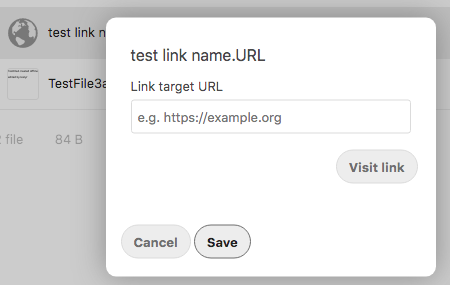
And that's it. Your link will appear in the list of files, with a globe icon to indicate it is an external link:
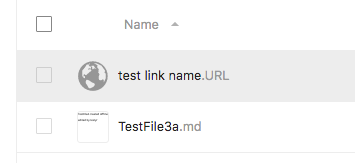
How to share a document with another Rebel
If you know that the user has access to the file - all users can access everything in the Library, and people in your group can access anything under your group folder - then get a 'Direct Link':
- Find the file in UKCLoud. Don't open it, click towards the right hand end of the row where the file size and date are. This will open the file info pane on the right.
- At the top of the Info pane is a thumbnail preview of the file (if one is available) or a file-type icon, under that is the filename and to the right a little icon

- Click the
 icon and a link will be copied to your clipboard ready for you to use.
This link will continue to work even if the file is updated, renamed or moved - so long as the person clicking the link has access to the file.
icon and a link will be copied to your clipboard ready for you to use.
This link will continue to work even if the file is updated, renamed or moved - so long as the person clicking the link has access to the file.
If the user doesn't have access to the file then you will need to share with a named user, as below.
How to share a file or folder
To open the sharing tab for a file or folder, click on the icon on the right of the file name. This may be a sharing icon  , a link icon
, a link icon  or the icon of the person who has shared it with you.
or the icon of the person who has shared it with you.
There are 3 types of sharing on UK Cloud:
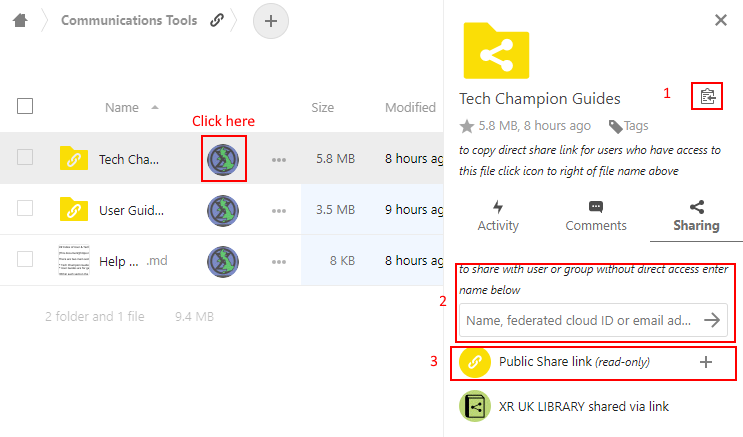
-
Sharing a link to someone else in your group, or another group that can see the file, so they can find it easily.
Click the copy link icon (1 in the screenshot above), which copies the link to your clipboard, from where you can paste it into any program (e.g. Mattermost or email). The link will only work for people that already have access to the file or folder on UK Cloud. -
Sharing with a named user or group on UK Cloud
Type the name of the user or group into the box (2 above). When you start typing, a list of names pops down to help you, to make it easier. When you click on one of the names, it creates a share in the list below. The file or folder will appear in the user's (or every user in the group, if you shared to a group) "All files" page as a share. Please don't do this unless the person or group you are sharing with really wants the share - otherwise you will clutter up their All files page with shares they don't want, and have to delete. The default is to share stuff so people can edit it, but you can alter the permissions with the ... menu next to the share. -
Sharing with everyone on the Internet Click the + sign next to Public Share Link (3 above). This creates a public share that anyone on the Internet can use, without having a login on UK Cloud. The share will be listed below, with a clipboard icon so you can copy it to your clipboard, from where you can paste it into any program (e.g. Mattermost or email). By default the share will be read only, with an expiration date, but you can change that with the ... menu. Obviously, please don't share any stuff that should not be public, especially including identifying details of people (unless you have their explicit permission in writing). Remember, if you share a folder, people can access everything in the folder and all its subfolders.
We suggest that most shares are done by a "role" login (a login and email that is attached to a role rather than an individual), because if someone leaves UK Cloud, their files and shares may become unavailable.
UK Cloud Features
The primary use of UK Cloud is to store and access files, including uploading, downloading and sharing.
Viewers - the following file types will open a viewer when you click them:
-
PDF files (.pdf) - this is the default for most documents in the Library
-
JPG, PNG and some other image files
-
Text files (.txt) - there is no built in editor for text files, the use of Markdown files is preferred.
To download a file, right-click on the filename.
For files with no built in viewer or editor clicking the filename directly downloads the file.
Editors - the following file types will open an editor or can be created by clicking the [+] button (if you have write permissions):
-
Markdown files (.md) - markdown is a text format with simple formatting. The Markdown editor/viewer allows many people to work simultaneously on the same document and automatically see each other's changes as they happen. Very useful for minutes edited during a meeting.
-
Mindmap files (.km) -- a built in editor to create and manage mindmaps is available by clicking the [+] button or on a .km file name.
-
Office files (.docx and .xlsx) - currently disabled
Apps - these are the default extra apps available which create and open their own files:
-
Gallery - for browsing and viewing multiple image files.
-
Deck - a Kanban style project management tool. Decks can be shared with others in a group to work collaboratively on a project.
-
Calendar - a personal calendar which you can share with others and link with your device calendars. Group Coordinators can use this to create a shared group calendar.
How to undelete a file
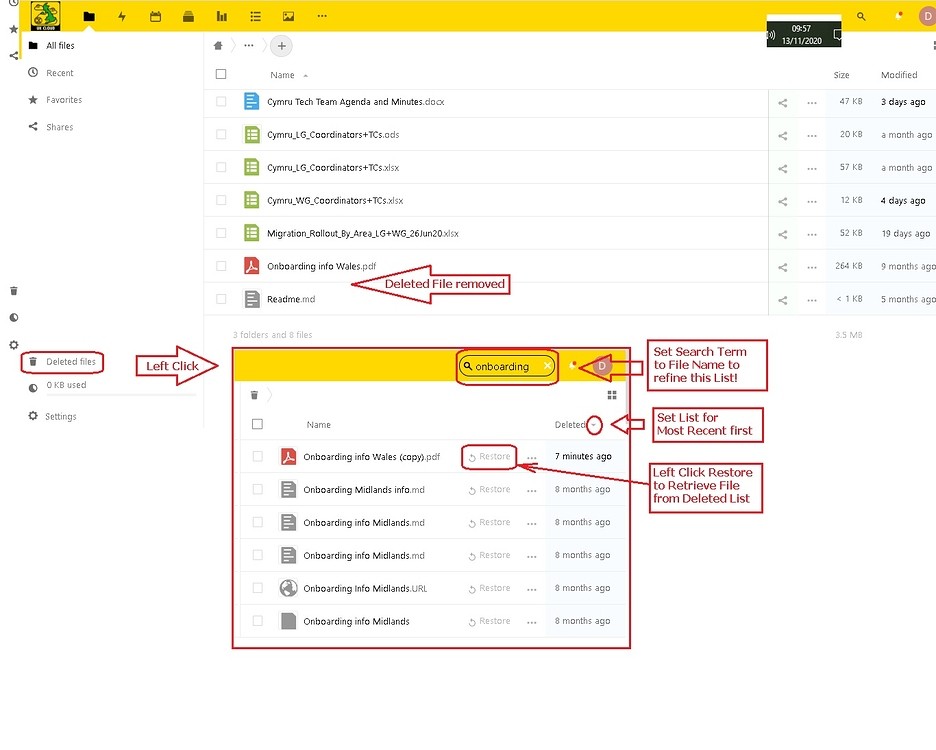
- If you want to find that Deleted File, click 'Deleted Files', bottom left of UK Cloud screen, and search the resulting Deleted Files List for the lost File.
- You may have to put the File Name into Search to help, as the Deleted File List may be long.
- Also, if it is a recently deleted File, then ensure the List displays Recent First (toggle the up/down arrow).
- Find the File, click 'Restore' and the File will be returned to its Folder.
How file storage is organised
As a user you have no personal storage area. UK Cloud facilities are not to be used for storing or sharing personal files, all files are the property of an XR group.
You will have read/write access to the storage areas for groups you belong to. Within a group's folder (on your home "All Files" page) any structure that suits the groups can be created.
N.B. Groups within UK Cloud may cover several groups within an XR Circle - for example a local group may have all of its working groups' folders within the main local group folder and available to all members of the group. Or a major working group may have its own private folder with sub folders for various teams and projects within the working group.
You will also have read-only access to some common folders - most of these you will find in the Library shared folder at the top level. There may also be other shared folders and files which have been shared with you by other groups or individuals - for some of these you might have been granted read/write access.
Although we do our best to keep the data in these tools reasonably secure, you must not post incriminating material of any kind here. By doing so you risk the authorities taking down the server, which would upset our communications severely. Not only would you risk your own arrest, but the arrest of the system administrators, who may be in a country with a repressive justice system.
How to change the order of the header icons
In the browser view of UK Cloud there is a row of icons at the left hand end of the yellow header bar:
 These link to the internal cloud apps (files, polls, forms etc) and some external websites.
These link to the internal cloud apps (files, polls, forms etc) and some external websites.
As the screen width is reduced the icons flip from the right into a three dots drop-down menu.

The default order of the icons is: Files | Activity | Calendar | Deck | Polls | Forms | Photos | UK Hub | UK Forum | Mattermost | UK Website
You can customise the order to suit your requirements:
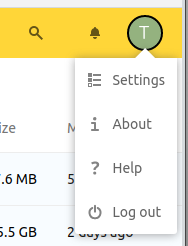
-
Click on your Avatar in the top right of the header and select "Settings".

-
In the left hand pane select "App Order". Uncheck any you don't want displayed and drag the remaining ones into the order you want.
Click away to something else and your ordering will be saved.
Why don't we have a document editor?
UK Cloud can view most common word processor, spreadsheet and similar documents.
We are working on shared editing of these...
Alternatives for shared editing on the Cloud
You can create a "Text Document" in the Cloud, which allows collaborative editing. You can format it in a limited way, but it doesn't have the features of a full word processor.
There is a Global XR Cryptpad which has shared editing of documents and spreadsheets. You can just use it as a guest, or sign up for a proper login. Once you have created a document on cryptpad, you can add a link to it on the cloud using New Link:

Why don't we have personal storage space?
Everyone’s Cloud account has 0 bytes of storage in their personal folder. This is for security reasons - if everyone had personal space, there would be nothing to stop someone uploading illegal material to their (fake) account, then reporting it to the police so they raid XR and shut down the servers.
Everyone has access to the read-only Library, and people in an XR group which has requested storage have full read-write access to their group’s storage (where we trust other members of the group would spot suspect files, and remove them).
